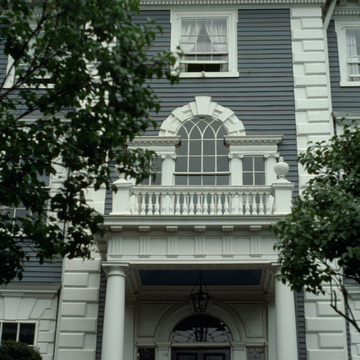You are here
John Nicholas Brown Center for the Study of American Culture (Joseph Nightingale–Nicholas Brown House)
Joseph Nightingale and his brother-in-law and partner, John Innis Clarke, built nearly identical houses beside one another on Benefit Street; Clarke's, one block south, burned in 1849. The Nightingale-Brown House is the largest extant wood-frame eighteenth-century house in the country. It is elaborately decked out in bold quoins and lintels, heavy turned balusters, and gable-on-hip roof, all retardataire for 1790. Such could be expected of Caleb Ormsbee, who was more a builder than a designer, but seems to have mustered all his resources to give Nightingale and his partner the images they wanted.
Nicholas Brown acquired the house in 1814, and his descendants remodeled and enlarged it in several campaigns. John Carter Brown (1797–1874) went to Tefft in 1853 for a brick barn and bowling alley in his round-arched style. He also commissioned an addition on the south side in 1858 and, finally, called on Upjohn in 1862–1864 for a library on the northeast to house his collection of Americana. Olmsted redid the grounds in 1890. John Nicholas Brown (1900–1979) oversaw the extensive remodeling of the interior by Jackson, Robertson and Adams in the 1920s. They left the center hall intact with its scenic wallpaper but changed the configuration of the northeast parlor and the southwest dining room. They also reworked much of the detail: the pedimented doorways and stair balusters in the hall are theirs (with inspiration from the interiors of the John Brown House); so is the refacing of the walls of the dining room with imported 1720s English paneling—stripped of paint, as was then stylish. Finally, in the late 1980s, it was adapted to its new use as a study center honoring the memory of John Nicholas Brown. The restoration, by Irving B. Haynes and Associates, involved extensive repairs to stabilize what was by then a seriously endangered fabric—in part because of natural causes, but as much because of the cumulative effect on the structure of piecemeal construction.
Writing Credits
If SAH Archipedia has been useful to you, please consider supporting it.
SAH Archipedia tells the story of the United States through its buildings, landscapes, and cities. This freely available resource empowers the public with authoritative knowledge that deepens their understanding and appreciation of the built environment. But the Society of Architectural Historians, which created SAH Archipedia with University of Virginia Press, needs your support to maintain the high-caliber research, writing, photography, cartography, editing, design, and programming that make SAH Archipedia a trusted online resource available to all who value the history of place, heritage tourism, and learning.
























